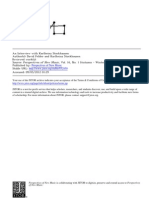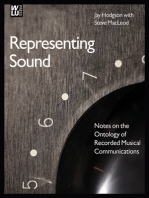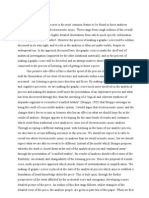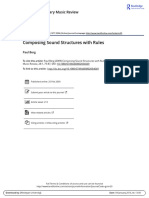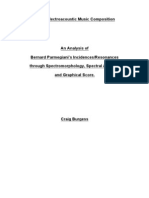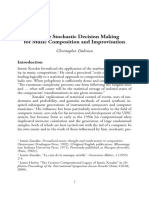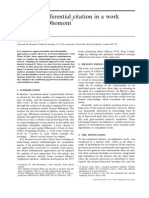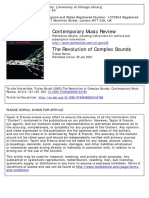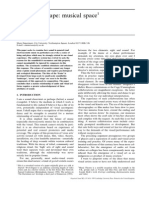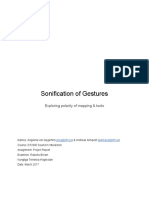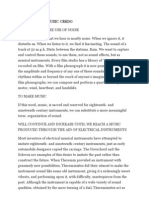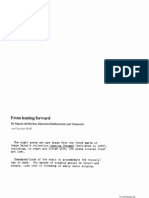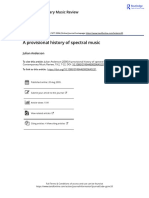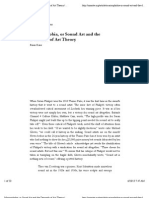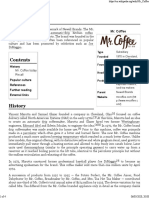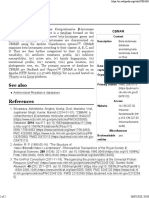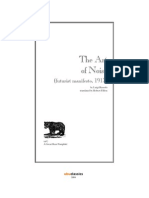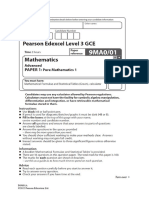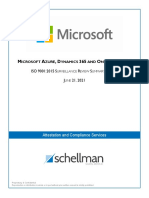Electroacoustic Music Studies and Accepted Terminology: You Can't Have One Without The Other
Electroacoustic Music Studies and Accepted Terminology: You Can't Have One Without The Other
Uploaded by
Jonathan HigginsCopyright:
Available Formats
Electroacoustic Music Studies and Accepted Terminology: You Can't Have One Without The Other
Electroacoustic Music Studies and Accepted Terminology: You Can't Have One Without The Other
Uploaded by
Jonathan HigginsOriginal Description:
Original Title
Copyright
Available Formats
Share this document
Did you find this document useful?
Is this content inappropriate?
Copyright:
Available Formats
Electroacoustic Music Studies and Accepted Terminology: You Can't Have One Without The Other
Electroacoustic Music Studies and Accepted Terminology: You Can't Have One Without The Other
Uploaded by
Jonathan HigginsCopyright:
Available Formats
EMS : Electroacoustic Music Studies Network Beijing 2006 - http://www.ems-network.
org
Electroacoustic Music Studies and Accepted Terminology:
You cant have one without the other
EMS06 Leigh Landy
llandy@dmu.ac.uk
www.mti.dmu.ac.uk
Summary This talk will summarise the conclusions of my latest book, Understanding the
Art of Sound Organization (to be published by MIT Press in the autumn of 2007), a
book that is based on recent years experience conceiving and directing the
ElectroAcoustic Resource Site (EARS) - http://www.ears.dmu.ac.uk. It is based on two
worries: 1) current terminology usage in the field is at best fluid and at worst in a fairly
weak state, especially category and genre terminology. This conclusion, the main focus of
this talk, corresponds with the EMS06 theme; and 2) the field of Electroacoustic Music
Studies (EMS), instead of engaging in foundational issues that have yet to be resolved,
tends to focus on aspects of investigation at higher levels. I often describe this situation as
follows: if EMS publications were to be presented in the form of a building, there would
be a significant number of upper floor suites and rooms inhabited, but at least some of the
foundation has yet to be designed. This unusual architecture is reflected in patterns that
are emerging on the EARS sites rapidly growing bibliography.
Clearly, these issues are interrelated. On the basis of the creation of the EARS sites index
structure and the above-mentioned patterns within its bibliography, areas of studies in
need of development will be introduced towards the end of this talk after sharing some
very odd discoveries concerning terminological issues that were noted whilst the sites
glossary was originally compiled and which remain unresolved today.
I shall choose to use a new term, one devised whilst writing this new book, as a
denomination of the field that I believe the EMS Network covers. A proposal will be
made to establish an international group investigating how we, not only in the English
language, but also in others, should start to define or redefine our terms collectively,
sharing language-based similarities and differences leading towards the creation of
dictionaries and a thesaurus of the most basic terms relevant to EMS in a number of
languages. The working groups results could be made public on the EARS site. The
group, possibly working under the auspices of the EMS Network, might also consider
what the field of electroacoustic music studies consists of, that is, what the full
architectural design of that building might look like.
The context of this talk During a substantial part of my career, one of my ides fixes has
been the investigation of how experimental forms of music, in particular musics
involving the organisation of sounds (in this case including, but specifically not focusing
on notes), can achieve the levels of participation and appreciation that they deserve. This
fascination has, of course, an outlet in my own artistic work. However, my compositions
are not a focus of todays talk. My investigations concerning access have several research
1/8
EMS : Electroacoustic Music Studies Network Beijing 2006 - http://www.ems-network.org
aspects in fact one of which was the theme of the talk I presented at EMS05 in Montreal,
namely the Intention/Reception project where, amongst other conclusions, it was
demonstrated that the potential audience for electroacoustic works is much higher than
the one that exists today or even the one envisioned by most specialists in the field. I refer
you to the publications on this project for further information (Landy 2001, Landy and
Weale 2003, Weale 2006, Landy 2006 and 2007).
The aspects related to access as far as this talk is concerned are two-fold: 1) how well
defined is our basic terminology, in particular our terminology related to genres and
categories? We will discover that there is room for improvement; 2) how well defined is
the field of studies found in the name of the organisation co-ordinating this series of
conferences, namely Electroacoustic Music Studies? I firmly believe that we have a
situation of a radical departure in music that is insufficiently supported by scholarship.
But what do these two points have to do with access? To be quite frank, they are both
access sine qua nons. Both the clear use of terminology, in particular that regarding
classification, and a field of studies supporting the understanding of this relatively new
musical corpus are fundamental in order to create avenues regarding access to this music.
Although interrelated, lets keep things simple and treat them separately. The key findings
in the next two sections have been discovered as part of research related to the EARS
site, a multi-lingual resource site consisting of a subject glossary in which disparate
definitions for individual terms are included where appropriate; an index is offered
primarily as the basis of the framework for bibliographic searches and there is also a
rapidly increasing bibliography. Furthermore, a multi-lingual thesaurus of index terms
will be introduced in 2007. For more information concerning EARS, please refer to
project publications (Landy and Atkinson 2003a, 2003b and 2004). Working during
recent years on EARS has led me to write the above-mentioned book in which a potential
framework for the field of Electroacoustic Music Studies is proposed. The key findings
are summarised in the following sections.
Terminology: We dont all have to agree, but the current state of affairs is embarrassing I
suppose I have to admit that the more scientific the terminology, such as acoustics-based
terms used in electroacoustic music, the less difficult or controversial they tend to be.
What my colleagues working on EARS and I have discovered is that terms related to
classification are in a fairly sorry state. So lets launch the classification debate.
Organised Sound: We all know where this term came from, Edgard Varse, who felt
dissatisfied with the word music describing his pre-electroacoustic compositions. One
can easily understand what he was driving at, not least the ability that all sounds can be
used in music. However there are two issues here: 1) does this imply that the term
organised sound is to replace music? and 2) what did Varse actually mean when he
coined the term? I believe that, perhaps with the exception of the Brussels performance of
his Pome lectronique, he meant works involving sound organisation that can be
presented within a musical context such as a concert. John Cage, on the other hand,
gladly borrowed this term but took a much more liberationist approach to its meaning.
2/8
EMS : Electroacoustic Music Studies Network Beijing 2006 - http://www.ems-network.org
His much cited: Music is all around us, if only we had ears implies that we can take
our concerts with us, as everything we hear is organised sound and thus music. Lets deal
with a specific case, an interactive sound installation in a public space. People who are
willing, come into the installation area and play it. What one hears is organised sound.
But is it also music? According to Varse possibly not; according to Cage absolutely. This
term has offered us two awkward problems, but things will get worse.
Sonic Art: On the EARS site, Sonic Art is defined as follows: this term generally
designates the art form in which the sound is its basic unit. Now, given what I said
earlier in the section about context, this is exactly my area of interest. But here again
there are problems, four this time: 1) Where do acoustic works fit here? This is actually
not problematic in terms of this or the next term, but it is certainly so with electroacoustic
music; 2) what is the difference between sonic art and sound art? I shall comment on this
in a moment; 3) do all languages offer an adequate equivalent of this term? The answer is
no. Just to give two examples, Klangkunst in German means and most often refers to
sound art. Lart sonore is not used that often in French due to the historical fact that les
arts sonores means music and is placed alongside les arts scniques (performing arts) and
les arts plastiques (fine art); 4) Last but by no means least, is sonic art music? Different
people will have different answers to this question. Sonic art is a term I would be
comfortable with were it to include the word music as I am very much influenced by John
Cage as far as organised sound is concerned and do not believe in separating sonic art
from music, something that is even more often pertinent with the next term.
Sound art: This term is used in a variety of manners, but I can say that the key concept
behind sound art is that it refers to works of sound organisation that are normally not
conceived for concert performance. They can be found in galleries, museums, in public
spaces, on the radio or wherever, but they are normally not presented as musical works.
There are, of course, historical reasons for this. Sound artworks tend not to have a
beginning or and end. Many choosing this term, but by no means all, have studied fine
arts and are making an art of sound. But how different is this compared with the sonic
arts? (Indeed, here is another problem; sonic art also appears in its plural form.) I think
that this boils down to intention: sound art is usually an art with an implied context, again
normally not a concert hall. Sonic art works may be played anywhere including the
concert hall. Lets put it this way for the moment; sound art is, in my view, a subset of
sonic art. That said, there are those who believe that sound artists are people who dont
qualify to be musicians. I personally have great difficulty with this view.
Electronic Music: Many people use this word as a synonym for electroacoustic music,
particularly in the US and also here in China. This is somewhat odd in my view, as a
soundscape composition, for example, which may involve subtle sound manipulation, but
does not normally involve any electronic generation, would fit under this category.
Electronic Music also has an historical connotation when used in German, elektronische
Musik. Electronic music means electroacoustic music in which sounds are generated
electronically to most people in my circles.
3/8
EMS : Electroacoustic Music Studies Network Beijing 2006 - http://www.ems-network.org
Musique Concrte/Acousmatic Music, etc.: Often misunderstood to be music using
concrete sounds (this was not Pierre Schaeffers original reason for using this term),
Musique Concrte has often been placed in opposition to elektronische Musik as one
involved sound generation and the other did not. We acquire an understanding of what
Schaeffer meant by this term by reading his theories on the subject including his views
concerning so-called reduced listening. This limitation was so important to Schaeffer that
one of his own protgs, Luc Ferrari, was expelled from the Parisian studios when he
started to compose what he would call Anecdotal Music, that is, music for heightened
listening using highly identifiable sound sources. Later other composers chose the term
Acousmatic Music above Musique Concrte. A battle between those two terms continues,
at least in francophone nations. In fact there are at least three other terms participating in
this particular wrestling match. Fortunately, many musicians have moved beyond this and
believe that all sounds can be used in an electroacoustic work and therefore the original
French/German separation is long redundant. I believe that Musique Concrtes purpose
was slightly defeated by the theory of its originator; Acousmatic Music is a nice
description of audio works on a fixed medium; it is only useful, howeer, in terms of
classifying todays compositions that celebrate Schaefferian ideals.
Electroacoustic Music: Definitions of this term vary greatly. Some believe that it refers
solely to music on a fixed medium; many believe that it only refers to art music. I see the
term as one that refers to any music in which electricity has had some involvement in
sound registration and/or production other than that of a simple microphone or
amplification (EARS site). This, of course, includes relevant forms of music with roots
in popular music traditions. I would perhaps qualify this further by saying that where the
above description is not the major focus in a given piece one can speak of using
electroacoustic techniques; where it is the primary focus one speaks of electroacoustic
music. I shall use the term in this manner from now on. The Canadians call this music
and its studies Electroacoustics. This has not caught on very much outside the country but
does relate the work involved with music making alongside scholarly research which is
intriguing. There is another question that is worth thinking about: How does
Electroacoustic Music differ from Sonic Art? Clearly Sonic Art may involve acoustic
works, so that is one point. Another is that there are electroacoustic works that fully
adhere to the definition, but do not necessarily focus on sounds in the sense used here, but
instead focus more specifically on timbral aspects of notes. Such works do not
necessarily belong to Sonic Art. Yet the two terms are often used interchangeably. The
Sonic Arts Network in the UK works happily with other nations electroacoustic music
organisations, such as EMAC here in China (where the e, as suggested, stands for
Electronic, not Electroacoustic). Then theres
Electronica: Although of reasonably recent vintage, this term is used in very different
ways by different groups. For many in pop music circles, it is used as a synonym for
electroacoustic music although when one digs a bit deeper writers tend to disagree with
each other about what belongs to each term and which genres fit together. In contrast, for
4/8
EMS : Electroacoustic Music Studies Network Beijing 2006 - http://www.ems-network.org
those involved in recent laptop performance, just to name one example, and who adhere
to concepts associated with Glitch, Electronica is what they make. However this music
hardly fits into most pop musicians uses of the term. There is little to no overlap here.
Similarly in French lectro may mean any electroacoustic music or those rooted
particularly in popular traditions. I tend to class much of the above within electroacoustic
music, but am intrigued to see how, in five years time, this term will be used.
Computer Music: Of all the terms here, this is the only one I would like to see disappear
in the not too distant future. Computer Music is a term relating to many disparate
communities ranging from electroacoustic music to audio engineering to cognition
(whose specialists are not terribly interested thus far in electroacoustic music as an object
of study) to people creating analyses, traditionally notated scores and computer-based
compositions for instruments.
Where does all of this leave us? It takes little imagination to see how these terms and
the various definitions relating to these terms relate to/overlap with one another. Two
abbreviations appearing here, EARS and the EMS Network organisation, both include the
word electroacoustic. It may therefore seem odd to note that, given the above list of and
these abbreviations, I am not particularly happy with this term. Electroacoustic Music has
those two disadvantages in terms of my interest, sound organisation. Sonic Art, on the
other hand, does not. However, the use of the word art provides an incentive for many
to disqualify this work as music. Again, I have difficulty with this.
So what does one do? I think the answer to this is two-fold. First I have decided in my
recent writings to be bold and reject all of these terms for the music I am involved with
and choose a new one. This may come across as highly egotistical, but I see no other way.
I believe that the definition of Sonic Art needs to be used with a term that includes the
word, music and because of this, I have come up with a new term, Sound-based Music as
it is clear. I have admitted that those who prefer the Varse view of Organised Sound to
Cages need not accept this new concept as Sonic Art may work well for them, but theres
still that problem concerning the terms inability to be translated easily.
The second thing I think that one should do, and I would hope that as a result of this
themed EMS06, we can start that project here in Beijing, is to create a working group of
experts on terminology to make suggestions internationally for a tighter usage of some of
these and associated terms. Suffice to say that when it comes to attempting to discover
some coherence in the music that fits within Sound-based Music, genre and category
classification is no easy task! This working group might look into an entire spectrum of
terms. A positive result would play a highly important role in terms of making this music
more accessible to non-specialists.
The Sound-based Music Paradigm Before moving on to the second area which I shall
now call Sound-based Music Studies, I would like to make one more proposal at this
point. I have used the words popular music and art music here, be it with great care. To
5/8
EMS : Electroacoustic Music Studies Network Beijing 2006 - http://www.ems-network.org
many the distinction between the two for most music is huge although there are fusion
works and works such as traditional folk music that may belong to both or neither. But
when it comes to Sound-based Music, how relevant is this distinction? As this is not the
subject of this talk, I will share one conclusion of my book, namely, that I believe that a
Sound-based Music paradigm exists that is not dependent on that boundary regardless of
whether some works are made based on traditions coming from one or the other side. I
have heard experimental popular music-based works from musicians I would not have
encountered were it not for the kindness of people who do have interests in those areas
sharing this music with me. Much of the music was of great interest to me and, I assume,
would be to many of my peers as well. I assume also that this goes both ways: people in
that particular community would be most interested in works that have roots within the
realms of contemporary art music, but they are currently unaware of it. Here is a typical
example: where does sound-based ambient music fit?
I mention this because it brings together all the types of music that should be investigated
within the realm of Sound-based Music Studies. It also could prove quite relevant to
discussions regarding the accessibility of this corpus of music. Clearly that example of a
public art interactive work, if it was found accessible by its public, has nothing to do with
the art music/popular music distinction and everything to do with sound-based music.
A Framework for the Field of Sound-based Music Studies As suggested above, research
in the EARS project has included a focus on terminology. It also has involved a focus on
finding means to structure our new field. In fact, just deciding on the sites six main index
headers was the hardest decision we made. They are: Disciplines of Study, Genres and
Categories, Musicology of Electroacoustic Music, Performance Practice and
Presentation, Sound Production and Manipulation and Musical Structure. A point implied
but not stated thus far is that these studies involve the music itself and the scholarly areas
relevant to the creation of that music. Technological and scientific developments are
obviously pertinent to this work, but do not in themselves form a focus as far as EARS is
concerned. Only when music technological or scientific work takes the music and its
context into account is it included in EARS and thus in our delineation of this area of
studies. This is also a description of the areas of interest to the EMS Network community.
Sound-based Music is clearly interdisciplinary and the first category, Disciplines of
Study, emphasises how many fields influence or form part of the area of research. Genres
and Categories is the platform for the above-mentioned coherence discussion. The
Musicology of Electroacoustic Music section is the heart of EARS. I shall expand on this
momentarily. The last three categories might lean more heavily on science and
technology, but are there in cases where such concepts are treated from a musical point of
view. For example, any discussion on sound spatialisation that discusses why this might
be useful or successful belongs to the realm. The technology of, say, ambisonics, on its
own is not included. Similarly, convolution or the use of neural networks as a structuring
tool is not of interest except when questions relating to musical creation and/or reception
are discussed.
6/8
EMS : Electroacoustic Music Studies Network Beijing 2006 - http://www.ems-network.org
In my research leading to the writing of my recently completed book I came to the
conclusion that existent theory fits into the following eight categories: 1) Musique
Concrte/Acousmatic Music; 2) Real-world Music and, more recently, Appropriation;
3) New Sounds (including Noise); 4) All Sounds are Sound Objects; 5) Formalised
Musics; 6) The Popular Dimension; 7) The Split between Fixed Medium and Live
Electronic Practices; 6) Sound Art > Sonic Art. The framework I have proposed
subdivides Sound-based Music Studies as follows: 1) Classification: from sound to work
level; 2) The listening experience; 3) Modes of discourse, analysis and representation;
4) Organising sound from micro to macro-level; 5) New virtuosity; and 6) New means of
presentation. Beyond these areas I also make a plea for historical writings to take history,
theory and socio-cultural impact into account and to avoid, where possible, the art/pop
divide as their histories, at least as far as this subject is concerned, are all intertwined. I
also return to the Disciplines of Study category to illustrate how these disciplines also
impact upon all six key areas. Time and space unfortunately do not allow for much
elaboration here. In the book the combination of an overview of existent theory and this
framework serves as a starting point for a discussion that complements that of
classification.
Electroacoustic or Sound-based Music or however you prefer to call it is introduced or
taught in a wide variety of ways. I have discovered that these introductions often exclude
things not due to a tutors preference, but instead because (s)he does not have access to
that information. I believe that if we, through the same or similar type of specialists
working group as the terminology group suggested above, took the trouble to create a
clear framework and contribute more foundational writing to the field, the information,
pedagogic or otherwise, that supports this music and, consequently, access to the music
would both increase enormously.
Bibliographic sources related to access-based research projects mentioned in this talk
Landy, Leigh
2001 Measuring Intention against Reception in Electroacoustic Music: a new
opportunity for analysis. Proceedings: International Computer Music
Conference 2001 Havana: 2629.
Landy, Leigh and Simon Atkinson
2003a Introducing the ElectroAcoustic Resource Site (EARS). International
Computer Music Conference 2003 Proceedings Singapore: 115118.
2003b About the Electroacoustic Resource Site (EARS) Project. SAN Diffusion.
November 2003: 4.
2004 The ElectroAcoustic Resource Site (EARS): Philosophy, foundation and
aspirations. Organised Sound 9/1: 7995.
7/8
EMS : Electroacoustic Music Studies Network Beijing 2006 - http://www.ems-network.org
Landy, Leigh and Rob Weale
2003 Measuring Intention against Reception in Electroacoustic Music. SAN
Diffusion. October 2003: 26.
2006 The Intention/Reception Project. in Mary Simoni, ed. Analytical Methods of
Electroacoustic Music. New York: Routledge: 2953 + appendix on DVD.
2007 Understanding the Art of Sound Organization. Cambridge, Mass: MIT Press.
(To be published during the autumn next year.)
Weale, Rob
2006 Discovering How Accessible Electroacoustic Music Can Be: The Intention/
Reception Project. Organised Sound 11/2: 189200.
8/8
You might also like
- Kompositionen für hörbaren Raum / Compositions for Audible Space: Die frühe elektroakustische Musik und ihre Kontexte / The Early Electroacoustic Music and its ContextsFrom EverandKompositionen für hörbaren Raum / Compositions for Audible Space: Die frühe elektroakustische Musik und ihre Kontexte / The Early Electroacoustic Music and its ContextsNo ratings yet
- Music, Sound and Sensation: A Modern ExpositionFrom EverandMusic, Sound and Sensation: A Modern ExpositionRating: 4.5 out of 5 stars4.5/5 (3)
- Analisis Electronic Music - Marco StroppaDocument7 pagesAnalisis Electronic Music - Marco StroppadavidNo ratings yet
- Amacher, Maryanne - Psychoacoustic Phenomena in Musical CompositionDocument16 pagesAmacher, Maryanne - Psychoacoustic Phenomena in Musical CompositionricardariasNo ratings yet
- The Apres-Garde - A History of Avantgarde MusicDocument72 pagesThe Apres-Garde - A History of Avantgarde MusicIgor Rosa0% (1)
- The Music of StockhausenDocument4 pagesThe Music of StockhausenAugusto César PaladinoNo ratings yet
- An Interview With Karlheinz enDocument18 pagesAn Interview With Karlheinz enplbrook100% (1)
- THORESEN Spec-Morph Analysis Acc SchaefferDocument13 pagesTHORESEN Spec-Morph Analysis Acc SchaefferAna Letícia Zomer100% (1)
- Spectromorphological Analysis of Sound Objects PDFDocument13 pagesSpectromorphological Analysis of Sound Objects PDFlupustarNo ratings yet
- Lasse Thoresen - SoundObjectsDocument13 pagesLasse Thoresen - SoundObjectschmr thr100% (1)
- Composition and Cognition: Reflections on Contemporary Music and the Musical MindFrom EverandComposition and Cognition: Reflections on Contemporary Music and the Musical MindRating: 5 out of 5 stars5/5 (2)
- Representing Sound: Notes on the Ontology of Recorded Musical CommunicationsFrom EverandRepresenting Sound: Notes on the Ontology of Recorded Musical CommunicationsNo ratings yet
- Graphic ScoreDocument5 pagesGraphic ScoreAlmasi GabrielNo ratings yet
- Alvin Lucier's Natural Resonant FrequenciesDocument3 pagesAlvin Lucier's Natural Resonant FrequenciesKimberly SuttonNo ratings yet
- Hernandez Lanza Aschenblume PDFDocument29 pagesHernandez Lanza Aschenblume PDF1111qwerasdf100% (1)
- Alvin Lucier - ChambersDocument7 pagesAlvin Lucier - ChambersAmarillo VejigaNo ratings yet
- Composing Sound Structures With RulesDocument14 pagesComposing Sound Structures With RulesErnesto FreieNo ratings yet
- François Bayle - Space - and - MoreDocument9 pagesFrançois Bayle - Space - and - MoreDaniel TapiaNo ratings yet
- Bernhard Lang Style and Idea IVDocument17 pagesBernhard Lang Style and Idea IVHäzÆl Çëdęrick JâsónNo ratings yet
- Desintegrations y Analisis EspectralDocument12 pagesDesintegrations y Analisis EspectralDavid Cuevas Sánchez100% (1)
- Alexander Schubert - Silent Posts ScoreDocument6 pagesAlexander Schubert - Silent Posts ScoreFrancisco MuñozNo ratings yet
- M Logos I0002 A0018 02 PDFDocument19 pagesM Logos I0002 A0018 02 PDF2413pagNo ratings yet
- Composing Intonations After FeldmanDocument12 pagesComposing Intonations After Feldman000masa000100% (1)
- Analysis of Parmegianis Incidences-Resonances-libreDocument29 pagesAnalysis of Parmegianis Incidences-Resonances-libreJohn HawkwoodNo ratings yet
- Stockhausen On Electronics, 2004Document8 pagesStockhausen On Electronics, 2004Mauricio Drada100% (1)
- Xenakis Electronic MusicDocument1 pageXenakis Electronic MusicCharlex López100% (1)
- Cool Memories: Notes On The Ligeti Viola Sonata John Stulz (2012)Document29 pagesCool Memories: Notes On The Ligeti Viola Sonata John Stulz (2012)Florian Wessel100% (1)
- Realtime Stochastic Decision Making For Music Composition and ImprovisationDocument15 pagesRealtime Stochastic Decision Making For Music Composition and ImprovisationImri Talgam100% (1)
- Stephane Roy - Form and Referencial Citation in A Work by Francis Dhomont - 1996 - Analise - EletroacusticaDocument13 pagesStephane Roy - Form and Referencial Citation in A Work by Francis Dhomont - 1996 - Analise - Eletroacusticaricardo_thomasiNo ratings yet
- Horacio Vaggione - CMJ - Interview by Osvaldo BudónDocument13 pagesHoracio Vaggione - CMJ - Interview by Osvaldo BudónAlexis PerepelyciaNo ratings yet
- Hugues Dufourt La Musique Spectrale UneDocument6 pagesHugues Dufourt La Musique Spectrale UnetekajNo ratings yet
- Spectral MusicDocument6 pagesSpectral MusicTheWiki96No ratings yet
- AS-Cross Synthesis Handbook PDFDocument80 pagesAS-Cross Synthesis Handbook PDFArchil GiorgobianiNo ratings yet
- Irin Micromontage in Graphical Sound Editing and Mixing Tool PDFDocument4 pagesIrin Micromontage in Graphical Sound Editing and Mixing Tool PDFAnonymous AqIXCfp100% (1)
- Murail. The Revolution of Complex SoundsDocument16 pagesMurail. The Revolution of Complex SoundsЯна Романчук100% (1)
- Simmon Emmerson: Aural LandscapeDocument6 pagesSimmon Emmerson: Aural LandscapeNuma Eduardo TortoleroNo ratings yet
- Music For Solo Performer by Alvin Lucier in An Investigation of Current Trends in Brainwave SonificationDocument23 pagesMusic For Solo Performer by Alvin Lucier in An Investigation of Current Trends in Brainwave SonificationJeremy WoodruffNo ratings yet
- The Visual Context of MusicDocument9 pagesThe Visual Context of MusicFabi UrbanNo ratings yet
- Sonification of GesturesDocument18 pagesSonification of GesturesAndreas AlmqvistNo ratings yet
- Electroacoustic Music of Iannis XenakisDocument25 pagesElectroacoustic Music of Iannis XenakisipiresNo ratings yet
- Ana Maria AvramDocument2 pagesAna Maria AvramSimon MathewsNo ratings yet
- Straebel-Sonification MetaphorDocument11 pagesStraebel-Sonification MetaphorgennarielloNo ratings yet
- Scratch Music - ReadingsDocument10 pagesScratch Music - Readingsemma_rapaportNo ratings yet
- Music and BoredomDocument7 pagesMusic and BoredomThomas PattesonNo ratings yet
- Murail InterviewDocument10 pagesMurail InterviewSandra GonzálezNo ratings yet
- Future of MusicDocument4 pagesFuture of MusicFrancisco EmeNo ratings yet
- Sound ArtDocument8 pagesSound ArtSheldonKesselNo ratings yet
- Rebonds - Structural AffordancesDocument22 pagesRebonds - Structural AffordancesStudy timerNo ratings yet
- Christian WolffDocument7 pagesChristian WolffLeo SvirskyNo ratings yet
- Improvisation and The Pattern Which Connects - Nachmanovitch (2007)Document14 pagesImprovisation and The Pattern Which Connects - Nachmanovitch (2007)Laonikos Psimikakis-ChalkokondylisNo ratings yet
- Notating Action-Based Scores67312247Document9 pagesNotating Action-Based Scores67312247Ken Stewart100% (2)
- 01-A Provisional History of Spectral MusicDocument17 pages01-A Provisional History of Spectral MusicVictor-Jan GoemansNo ratings yet
- Sobre Lachenmann y PercepcionDocument5 pagesSobre Lachenmann y PercepcionFilipe Carlos Vieira100% (1)
- Clashing Harmonic Systems in Haas's Blumenstück and in Vain - Robert HasewagaDocument21 pagesClashing Harmonic Systems in Haas's Blumenstück and in Vain - Robert HasewagaKristupas Bubnelis100% (2)
- Musicophobia, or Sound Art and The Demands of Art TheoryDocument20 pagesMusicophobia, or Sound Art and The Demands of Art Theoryricardarias100% (1)
- Electroacousticmusic of XenakisDocument26 pagesElectroacousticmusic of Xenakisrhyscorr100% (1)
- Compositionalmodels XenakisDocument44 pagesCompositionalmodels XenakisVicente Barba VarelaNo ratings yet
- Tristan Murail - Target Practice PDFDocument24 pagesTristan Murail - Target Practice PDForbs100% (1)
- Saariaho - The Music of Karja Saariaho (Julian Anderson)Document5 pagesSaariaho - The Music of Karja Saariaho (Julian Anderson)Francesco Melani100% (1)
- Stockhausen On OperaDocument17 pagesStockhausen On OperaMikhaelDejanNo ratings yet
- Mr. CoffeeDocument4 pagesMr. CoffeeJonathan HigginsNo ratings yet
- Cbmar: See AlsoDocument2 pagesCbmar: See AlsoJonathan HigginsNo ratings yet
- Chhutir GhontaDocument2 pagesChhutir GhontaJonathan HigginsNo ratings yet
- Experiential Learning: Experience As The Source of Learning and Development - KolbDocument23 pagesExperiential Learning: Experience As The Source of Learning and Development - KolbJonathan HigginsNo ratings yet
- Matryoshka: For Prepared Piano + Live ElectronicsDocument5 pagesMatryoshka: For Prepared Piano + Live ElectronicsJonathan HigginsNo ratings yet
- The Art of Noises - RussoloDocument16 pagesThe Art of Noises - RussoloJonathan Higgins100% (2)
- Rite of Spring Essays From Sketch ScoresDocument16 pagesRite of Spring Essays From Sketch ScoresJonathan HigginsNo ratings yet
- 2022 Pure Maths Paper 1 9MA0 01Document12 pages2022 Pure Maths Paper 1 9MA0 01kafiazabit200No ratings yet
- GEZE Installation Instructions en 808460Document28 pagesGEZE Installation Instructions en 808460PiotrNo ratings yet
- Mark Scheme (Results) June 2016Document16 pagesMark Scheme (Results) June 2016Chibi EchanterNo ratings yet
- Vitamin D2 (Enregistrement Automatique)Document24 pagesVitamin D2 (Enregistrement Automatique)Zineb ZenayNo ratings yet
- 2024 State of The Nation Address by His Excellency Dr. Nangolo Mbumba 14 March 2024Document20 pages2024 State of The Nation Address by His Excellency Dr. Nangolo Mbumba 14 March 2024HenryNo ratings yet
- Project - 06 - Advanced Java Programming Ver 1.0Document12 pagesProject - 06 - Advanced Java Programming Ver 1.0kapileswardoraNo ratings yet
- Edinburgh Castle Power PointDocument12 pagesEdinburgh Castle Power Pointlaurcahs100% (3)
- Environmental and Industrial CorrosionDocument177 pagesEnvironmental and Industrial CorrosionEmanuelle SousaNo ratings yet
- Medusa (Comics)Document9 pagesMedusa (Comics)Maja Zvezdana KojadinovicNo ratings yet
- Winserver2 Volvo Viewinglibrary ST 160 2012 07 10 PDFDocument29 pagesWinserver2 Volvo Viewinglibrary ST 160 2012 07 10 PDFLuis JesusNo ratings yet
- Guidelines: Garib Kalyan Rojgar AbhiyaanDocument26 pagesGuidelines: Garib Kalyan Rojgar Abhiyaanpr1041No ratings yet
- Polymer: Takumitsu Kida, Masayuki YamaguchiDocument9 pagesPolymer: Takumitsu Kida, Masayuki YamaguchiraulNo ratings yet
- Solar Standards Development VFinal-SEIADocument48 pagesSolar Standards Development VFinal-SEIAGorka AguirreNo ratings yet
- 10.1007 BF02834801 Design of Forging Dies For Forming Flashless Ring Gear Blanks Using Finite Element MethodsDocument15 pages10.1007 BF02834801 Design of Forging Dies For Forming Flashless Ring Gear Blanks Using Finite Element Methodspedram khazaieNo ratings yet
- 8 1 IdentityIQ Privileged Account Management GuideDocument20 pages8 1 IdentityIQ Privileged Account Management Guidephenhomenal ecommerceNo ratings yet
- Prepared By:: An Internship Report of Nepal Rastra Bank (NRB)Document25 pagesPrepared By:: An Internship Report of Nepal Rastra Bank (NRB)Subin SthaNo ratings yet
- Rules and Regulations For The Courses Governing in RGUHSDocument12 pagesRules and Regulations For The Courses Governing in RGUHSMr.Indian BeastNo ratings yet
- 4 Argumenta Philippe Huneman and Marion Vorms Is A Unified Account of Conspiracy Theories PossibleDocument7 pages4 Argumenta Philippe Huneman and Marion Vorms Is A Unified Account of Conspiracy Theories PossiblesikedbruhNo ratings yet
- Polytechnic InfoDocument296 pagesPolytechnic Infonit_kharcheNo ratings yet
- Virus Final EssayDocument13 pagesVirus Final Essayapi-707766966No ratings yet
- Namkeen Manufacturing Unit: Project Report ofDocument23 pagesNamkeen Manufacturing Unit: Project Report ofShraddha PundNo ratings yet
- Showa CompanyDocument1 pageShowa Companytungle0908No ratings yet
- Health and Safety Management PracticeDocument18 pagesHealth and Safety Management PracticeDhana RajuNo ratings yet
- Rules: Trust Form ("Pure" Trust)Document2 pagesRules: Trust Form ("Pure" Trust)AC-WPM-MM-SWISSINDO JEREMIAH HART100% (8)
- Kenwood B64-4048-00 PDFDocument116 pagesKenwood B64-4048-00 PDFlmendizabalNo ratings yet
- ASPEC Safe Operation of Camera CranesDocument28 pagesASPEC Safe Operation of Camera CranesM. GuidoNo ratings yet
- Microsoft Azure, Dynamics and Online Services ISO 9001 Report - June 2021 PDFDocument34 pagesMicrosoft Azure, Dynamics and Online Services ISO 9001 Report - June 2021 PDFSteve CastroNo ratings yet
- Form 4 Poa Notes Week 5 Term 1 2021-2022Document3 pagesForm 4 Poa Notes Week 5 Term 1 2021-2022Kevin Mahabir 4BNo ratings yet
- Negative StainingDocument3 pagesNegative StainingDip MajumderNo ratings yet
- Amended LHC ComplaintDocument78 pagesAmended LHC ComplaintRtrForumNo ratings yet






